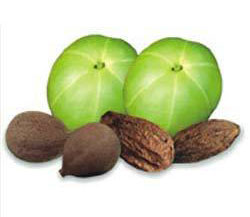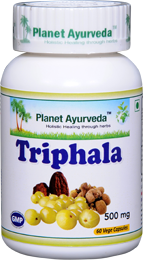
Triphala is one of the choicest laxatives and colon cleansers very popularly used nowadays. It is a household name and is one of the most commonly available over the counter medicines. The word Triphala literally means, three fruits namely, Amalaki (Emblica officianalis), Haritaki (Terminalia Chebula) and Vibhitaki (Terminalia Bellarica) mixed in equal parts in powder form.
Triphala is a classical ayurvedic preparation and has been mentioned at many a places in Ayurveda texts for the maintenance of abdominal organs in the body. It has all the tastes except for salty and is great for restoring youth and activity of the body tissues. Some people may find it bitter to taste but one tends to adapt to its taste with regular use.
Triphala and Tridoshas
Ayurveda considers human body as a constitution of largely, three types of body energies which combine in various combinations to impart unique qualities to each and every person on a physical, mental and psychological level. These three energies are namely, Vata or the ethereal body humor, Pitta or the Fire body humor and Kapha or the watery body humor. Ayurveda considers all these three energies to be responsible for all the bodily processes that sustain a healthy life. An imbalance of these three body humors singly, or in conjunction with each other lead to the development of disease.
Whatever food we eat on a daily basis has to be efficaciously digested to prevent the formation of any residual matter that gets stuck in the intestinal lumen leading to the formation of gases which in time, becomes a big store house for microbial infestations.
Given our daily eating habits and lifestyle, the food we eat is neither very high on nutrition, nor is it balanced enough to allow for proper digestion in the alimentary canal. As a result, there occurs accumulation of undigested food material which leads to the formation of “Ama” or the toxic byproducts of digestion in the body. This formation of Ama, is the reason for a large number of health problems that people suffer from these days.
There have been many renowned scholars in the history of Ayurveda who have published very scientific comments on how the human body works and what are the ways in which we can naturally keep this body healthy.
One of such Ayurvedic principle upholds that the health of digestive system is of prime importance and any disease which inflicts the body has a direct or indirect connection to some or the other fault in the digestive system.
That is why many people believe that Ayurveda is just a science dealing with digestive health problems. Contrary to this common belief, Ayurvedic principles boast of holistic health and promote measures to preserve this health for a healthy and long life.
1. Amalaki
Amlaki or Amla is better known as Gooseberry. In India, it is commonly called as Indian Gooseberry. Botanical name of this fruit is Emblica officianalis.
It is considered as a sacred tree in India according to Hindu mythology as Lord Vishnu is believed to reside in it.
The fruit is abundant in flavonoids, polyphenols and carotenoids besides the richness of vitamin C which is found in this fruit in maximum amounts as compared to any other herb.
In Ayurveda, Acharya Charaka has categorized herbs like Amalaki under the heading of Rasayana. Rasayana are substances which uphold health and wellbeing while restoring youth and maintaining health.
Amalaki is one of such fruits which is full of anti –oxidants, vitamins and minerals. You can take it a fresh or consume it as fresh juice for your daily dose of antioxidants.
Fruits of Amla are used to prepare triphala powder.
2. Haritaki
Haritaki also known as Terminalia Chebula is an herb with many nutritional benefits. Haritaki or harara as it is popularly called is as the dried fruit of the deciduous trees of the Terminalia Chebula. The trees are huge growing to an average height of 1800 meters.
The tree is the source of many chemicals like Tannic acid, Chebulinic acid, Gallic acid, resin, Anthraquinone, Sennoside, mucilage, Chebulin, Terchebin, Palmitic acid, Stearic acid, Oleic acid, Linoleic acid, Behenic acid etc.
Haritaki fruits are small, yellowish nut like and greenish in color when picked afresh.
Haritaki is used in a variety of Ayurvedic formulations which are used as supplements for maintaining health.
3. Vibhitaki
Terminalia bellirica or Bahera is a tall tree of the plains and lower Himalayas where it grows in long alleys of trees. The tree has been recognized by the ancient Hindus as possessed by Demons and is therefore its shade should be avoided by humans.
There are two varieties of T, bellirica found in India. One has large, oval fruits and the other bears globular fruits.
The fruits bear astringent properties and are used for multiple purposes.
Dried powder of Bahera fruit pulp is used for making Triphala powder.
Equal parts of Amalaki, Haritaki and Vibhitaki powder are used for the preparation of Triphala powder.
Planet Ayurveda’s Triphala Capsules
Planet Ayurveda is a renowned name known for making best natural supplements inspired by the Ayurvedic principles expressed in the ancient texts on Ayurveda.
Triphala capsule is a unique natural formulation from Planet Ayurveda which contains standardized extract of all these three herbs packed in 500 mg of pure vegetarian capsules.
The standard dosage of these capsules is 1 capsule twice daily with plain water after meals. It may vary from person to person as per the requirement.
Dosage of Triphala Capsules
Triphala capsules contain only natural herbs, even the outer capsule shell is made up from plant pulp and purely vegetarian.
- Triphala for Cleansing – 2 capsules twice daily
- Triphala for constipation – 2 capsules twice to thrice daily.

